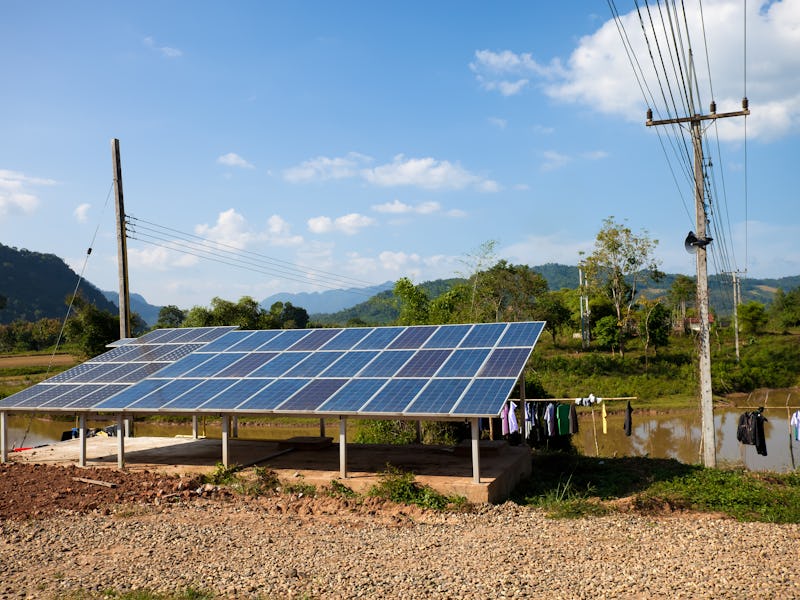Combining two global crises could save the global environment
The climate crisis is huge. The debt crisis is huge. But what if they could solve each other?

Any number of crises plague our world, but these crises do not exist in isolation. Climate change is a huge, well-documented problem which threatens our species survival, and in particular, people living in regions without significant infrastructure or on islands. Then there is the worldwide debt crisis, which the World Bank says, for some countries, is so massive that it constitutes a “red alert," and may ultimately lead to global economic collapse.
One problem is rooted in carbon dioxide emissions, the other, in finance. But a new paper published Thursday in Science argues these two can be solved hand-in-hand, and it all starts with China.
Solar panels have been crucial to Chinese energy growth. That could go global, a new paper says.
Why it matters — China is the world’s greatest source of bilateral credit. Through two government-owned banks, the China Development Bank and the Export-Import Bank of China, the country has lent out an astonishing $464 billion to other, mostly lower-income countries since 2008. China has provided African countries with more than $143 billion in loans in the last two decades, much of it as part of the country's "Belt and Road Initiative."
But any way you slice it, a plethora of countries around the world owe China tremendous sums of money.
Too much national debt and the inability to pay it off carries serious consequences. Laos was recently forced to cede majority control of its national power grid to a Chinese company due to its debt. Almost half of Angola’s exported petroleum has gone to China as a result of its debt contracts.
As a result, China's willingness to lend has been characterized as a “debt-trap,” with China essentially taking over a country’s sovereignty, according to the paper. But Blake Simmons, a Postdoctoral Research Fellow at the Global Development Policy Center at Boston University and co-author, tells Inverse these fears are overrated.
The notion of a debt-trap “has been proven wrong many times, even before the pandemic,” Simmons says.
“Since then, China has been the largest participant in G20 debt schemes.”
Most recently, China extended its debt relief to $2.1 billion around the globe — the highest amount of debt relief offered by any nation. In this effort, Simmons and his co-authors see an opportunity.
Angolan forests are beautiful but mostly unprotected. That could provide an opportunity.
The big idea — “Debt-for-nature,” or “debt-for-climate” schemes propose that the creditor (in this case, China) offers a swap to its debtors. In exchange for debt relief, a country would make a large-scale effort to benefit the environment.
What this would look like in practice depends on the individual country. To use Angola as an example, Simmons and his co-authors note ninety-one percent of the country’s “intact areas,” unbroken natural landscapes, are unprotected — in part due to the country’s civil instability. Simmons and his co-authors suggest this frustrating reality “provides an opportunity for debt- for-nature swaps to protect these landscapes and reduce relatively high rates of tree cover loss.”
With green spaces like Angkor Wat mostly protected in Cambodia, any swap would have to get creative.
Of course, not every country shares Angola’s large areas of unprotected environment. Cambodia, for instance, has protected much of its wild green space. But past efforts to cease logging, for example, were criticized as ineffective and put in place to benefit wealthy logging interests. All of this, Simmons says, means that Cambodia and other countries like it may “need to get creative when designing debt-for-nature swaps.”
The model offers “a lot of flexibility for alternative mechanisms," Simmons says.
"Whether it is enhancing the resources available to strengthen protection and enforcement within existing protected areas, or funding bottom-up, community-led conservation initiatives, such as indigenous protected areas or various agri-environmental schemes to promote conservation in production landscapes.”
China's proposed Belt and Road Initiative, first launched in 2013
What’s next — There are “several challenges that will need to be overcome” for debt-for-climate swaps to become a reality, with the first challenge being “political buy-in from China," Simmons says.
Anthony Rowley, an Asian financial expert who focuses on Chinese debt and is author of the recent book Foundations of the Future: the Global Battle for Infrastructure, agrees. He tells Inverse the concept of debt-for-nature swaps are “very imaginative and constructive." Rowley was not involved in the study.
The “entire world would benefit” from these credit swaps, Rowley says.
China would take the largest hit by losing any possibility of financially recouping their loans, however.
“There would presumably need to be some way of compensating China,” Rowley says. He suggests China could claim the carbon offsets derived from the swaps “for itself.”
Swaps could also prove tempting to China’s government and the Chinese Communist Party, allowing them to “publicize the exercise as an example of enlightened self interest," he says.
Implementing debt-for-nature and debt-for-climate swaps would “certainly” go a long way towards silencing critics of Belt and Road, Rowley says.
Even with political buy-in from the Chinese Communist Party, there would still be many challenges along the path — “from negotiations to on-ground enforcement,” Simmons says.
A current running through all of these challenges will be making such abstract financial decisions feel real to people on the ground.
Most importantly, governments need to “generate support from local communities, and prioritize actions that can realistically mitigate threats to nature, climate, and people in their own unique context," Rowley says.
This article was originally published on